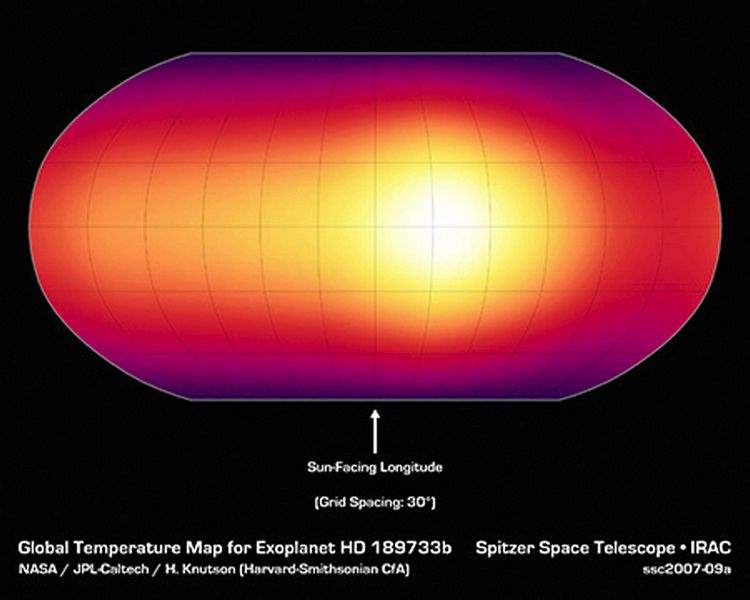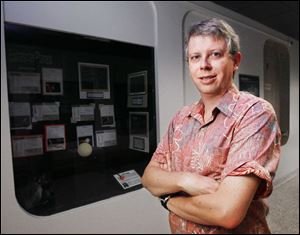
Hot, mighty winds fan distant planet, UT researcher says
5/10/2007
The brighter the hue, the hotter the temperature in this map of infrared temperature measurements on the extra solar planet, HD 189733b. The measurements taken by NASA's Spitzer Space Telescope show though the planet's hot side is sizzling, its cool side isn't really cool. Heat is carried all over the giant gas globe by winds faster than the speed of sound. Megeath
Spitzer Space Telescope / NASA/JPL-Caltech/H. Knutson (Har

The brighter the hue, the hotter the temperature in this map of infrared temperature measurements on the extra solar planet, HD 189733b. The measurements taken by NASA's Spitzer Space Telescope show though the planet's hot side is sizzling, its cool side isn't really cool. Heat is carried all over the giant gas globe by winds faster than the speed of sound. Megeath
A University of Toledo researcher helped take the temperature of a planet 60 light years away, revealing a world where weather is a mixture of hell and hurricane. A really, really, really big hurricane.
S. Thomas Megeath was part of a team using the space telescope named for Toledo-native and astrophysicist Lyman Spitzer to look at a planet in the constellation Vulpecula, or "little fox."
The journal Nature released a report on this research today.
"This is the first time we can actually start studying the atmosphere [of an extra-solar planet] in any detail," Mr. Megeath said. "This gives us an insight into planets that are very different from anything we imagined before. It's a window on a very exotic system."
How different is HD 189733b?
Adam Showman, of the University of Arizona Lunar and Planetary Laboratory, said his models predict winds faster than the speed of sound. And it is a planet where sound travels at 6,700 mph, about 10 times faster than it does on Earth.
Mr. Showman's team had been developing planetary weather models, based in part on what is known about Earth's climate, for some time. But they don't yet explain the observations from the Spitzer space telescope.
The sticking point is a new measurement of the temperature on the planet's hot side.
HD 189733b is among 233 planets discovered thus far outside our solar system - including three found earlier this month.
It races around its star at astonishing speeds, completing its orbit in 53 hours.
Although the planet is 30 percent bigger than Jupiter, it's so close to its star that it ought to sizzle.

Megeath
While our solar system's closest planet, Mercury, lies about halfway between the Earth and our Sun, HD 189733b is less than 1 percent of that distance from its star.
That proximity means HD 189733b doesn't spin on its axis, but is forced by gravity to always show the same face to its star, the way the moon shows only one face to the Earth.
So only the planet's cooler surface faces outward, toward observers. The planet's hotter face is usually hidden, appearing only just long enough to hide behind its star again.
But that turned out to be enough and led to a surprising discovery.
It seems the planet's "cool" side is nearly as much an inferno as the "hot" side. Measurements showed the cool side was 1,300 degrees Fahrenheit, compared to 1,700 degrees on the hot side.
No one predicted that.
Research published last year in the journal Science showed the planet Upsilon Andromeda b had one icy face and one fiery one, with a difference of some 2,500 degrees Fahrenheit between its two sides.
The reason for that discrepancy between the two planets is unclear, although Mr. Megeath pointed out the measurements of Upsilon Andromeda were far less extensive.
"They got only a few points," he said, whereas the new measurements were taken continuously, over 33 hours.
"It was never designed to do this. We're actually pushing the instruments," said Mr. Megeath, whose job was to characterize and calibrate the Spitzer's instruments.
"Measurement with this precision was never one of the requirements."
Mr. Showman said his models predicted that even 6,000-mph winds would cool considerably by the time they reached the other side of the planet.
Now, with the latest measurements, it may be that winds are even faster than initially predicted, and help account for the relatively even temperatures around the planet.
"There are two possible resolutions," he said. "One is the winds are extremely fast, several times the speed of sound - three, four, five times the speed of sound. That would probably be fast enough not to cool off.
"The other possibility is our estimates for how long it takes air to cool are wrong. Maybe the winds aren't that fast."
Contact Jenni Laidman at:
jenni@theblade.com
or 419-724-6507.